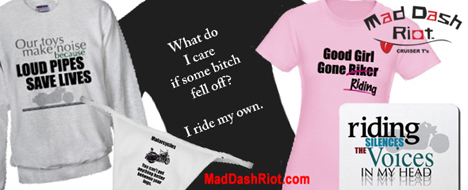Tips For Painting Your Motorcycle
by Sarah H
Here are some instructions to help you paint your motorcycle yourself and save a bunch of money by doing so.
Materials Needed
- Reducer
- Plastic Filler
- Flowable Putty
- Primer and Hardeners
- Epoxy Sealers
- Base Color Paint
- Clear Coat/Hardener
- 80,120,400,600,1500,2000 grit wet/dry sandpaper
- 2 Paint Guns
- Respirator for the Type of Paint You Are Using
Homemade Paint Booth
To create a homemade paint booth in your garage or shed, here’s what you need to do. First, put plastic over all of the walls. This not only protects your walls, but helps to reflect the light so you can see better. Once you have the plastic up, put fans in the windows. Tape around the edge of the fans to seal it to the plastic around them.
You need to make the paint booth as bright as possible so that you can see what you’re doing. You can buy temporary fluorescent light fixtures inexpensively at Home Depot or Lowe’s. These work great for this sort of project, and they are easy to hook up since they just plug into an outlet or extension cord.
Safety Precautions
There are some things you need to think about before you paint. First of all, paint fumes can be toxic, and they are also flammable. For these reasons, the place where you are painting should not be attached to your house.
If you wire your light fixtures in, make sure that you do it properly. Be sure that you have the covers over the light fixtures to protect them from the paint. You will also need to use a respirator while painting to protect you from the fumes. Make sure the respirator has the right kind of filter for the type of paint you are using.
Paint Equipment
In order to paint your own motorcycle you will need to have at least two paint guns. You will also need an air compressor, air hose and a regulator with a water trap. The first paint gun is for the primer and the second is for the base coat and clear coats.
Preparation
You need to check your motorcycle’s fuel and oil tanks before you begin painting. Make sure they are pressure tested and free of leaks. You should start by sandblasting the metal parts on your motorcycle to remove the old paint. If you don’t have a sandblaster, you can use sandpaper to sand them. Wipe down the parts you sanded with a non oil-based degreaser before you begin painting.
You will need to apply filler to the low spots. Mix it in small batches. It hardens quickly. Make sure you apply it as smoothly as possible. Sand it with 80 grit sandpaper after it dries, then check for any nicks or low spots. Fill them and repeat the sanding process. Once everything is smooth, it’s time for the primer.
Apply two coats of epoxy primer. After it dries, use a spray bomb of black paint and spray it over the surface very lightly. This will make any defects in your fill work show. Use a light finishing putty to repair these trouble spots. Apply it in even coats, then use a foam sanding block wrapped in 80 grit sandpaper to smooth it, followed by 120 grit then 400 grit.
Now apply the last coat of primer. Once it is dry, use 400 grit sandpaper to roughen to surface a little so that the base coat will stick better. Apply a coat of epoxy sealer before applying the base coat. This will provide a better surface and help prevent bubbles.
Make sure you read the instructions for the paint you are using and allow the correct about of time between coats. Also, make sure you mix the paint properly and paint when the temperature is within the acceptable range, or in a temperature-controlled building.
Base Coat & Clear Coat
Apply your color according the instructions provided by the manufacturer, then apply a layer of clear coat. After the first coat of clear coat has dried, use 600 grit sandpaper to wet sand it smooth. Sand until the ridges that appear as you sand disappear.
If you are going to paint graphics on your motorcycle, paint the graphics next. Then apply another coat of clear. You may need two coats of clear over the graphics. Wet sand with 600 grit sandpaper between each coat of clear. After you sand the last clear coat with 600, sand it again with 1500. To make the finish even smoother, you can follow that up with 2000 grit.
Polishing
You will need a variable speed polisher with a buffing pad for the last step, and some polishing compound. The store where you buy your supplies can recommend a good polishing compound to use. Now all that is left to do is buff it out for the perfect mirror finish, then sit back and admire your work.
For more great info on motorcycles visit www.motorcyclefactguide.com a website offering tips, advice and resources on topics such as buying motorcycle tires, motorcycle gear and even about the different types of motorcycle bikes plus so much more.
Article Source:
http://EzineArticles.com/?expert=Sarah_H
http://EzineArticles.com/?Tips-For-Painting-Your-Motorcycle&id=1064956
Category: Motorcycle Savvy


